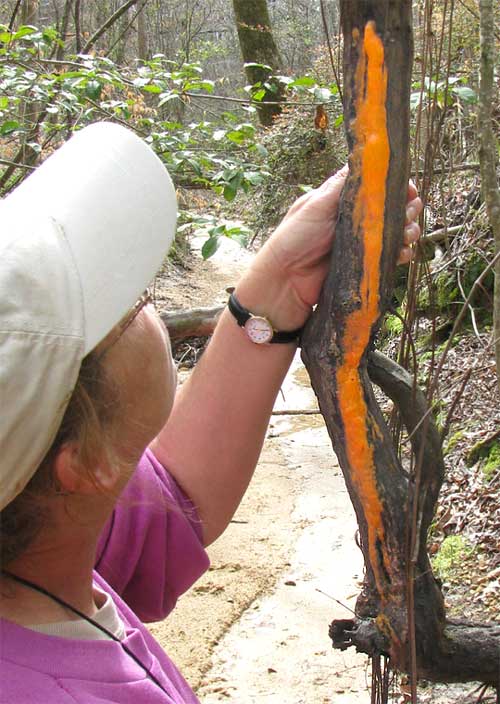Excerpts from Jim Conrad's
Naturalist Newsletter
from the March 31, 2013 Newsletter issued from the Frio Canyon Nature Education Center in northern Uvalde County, southwestern Texas, on the southern border of the Edwards Plateau; elevation ~1750m (~5750 ft); N29.62°, W99.86°; USA
MYSTERIOUS ORANGE SLIME
In March of 2009 in southwestern Mississippi one morning my friend Karen and I were hiking in the sandy bottom of a deep ravine, or bayou as they're called there, when we came upon a wild Muscadine grapevine at the ravine's edge, from which a slimy, bright orange, jellylike substance clung to the grapevine's stem, as shown below:

I didn't know what it was but I guessed that it must be a fungus or slime mold. When I sent the picture to mushroom guru Tom Volk at the University of Wisconsin and he had no idea, either, I asked readers for help.
Years passed, several people in the Deep South found similar orange slime and wrote asking me if I'd ever figured out what the slime was. Such a letter arrived this week, sent by Mark Musselman, Education Director at the Audubon Society's Francis Beidler Forest in South Carolina. For, it's March again, and the orange slime is appearing all across the Deep South. We both set about chasing the identity again, and eventually Mark stumbled upon a forum at the Mushroom Observer website where someone referenced an article in the Journal of the Mississippi Academy of Sciences, dated April 1, 2003 and entitled "The occurrence of Fusarium merismoides var. chlamydosporale (Tuberculariaceae) in Rankin County, Mississippi." The article referred to a "very wet, brilliant orange mass growing on a wild grape vine."
On the Internet, pictures of Fusarium merismoides seem to match ours.
Since that paper was published, Fusarium merismoides has been switched to the genus Fusicolla, so we can say that our orange slime is being produced by FUSICOLLA MERISMOIDES -- which, by the way, all along has been known by backwoods Southerners by the name of Deer Vomit.
But, it's not as simple as that...
In 2011 at the Fourth International Barcode of Life Conference in Adelaide, Australia a poster was presented on "The International Tree Slime Project DNA barcoding of fungal volcanoes." Fungal volcanoes! That sounds better than Deer Vomit, I must admit. And there it is stated that "Fusicolla merismoides (family Nectriaceae) is often considered the definitive tree slime fungus. This appears to be a large complex of many phylogenetic species. Almost every strain barcoded to date has a different sequence."
So, the fungus causing our orange slime/Deer Vomit/fungal volcanoes on Deep South grapevines apparently is actually several fungal species
In that document you can also see a tremendous example of orange slime -- called slime flux there -- on a dogwood tree in Japan.